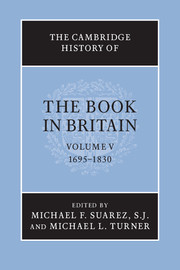Crossref Citations
This Book has been
cited by the following publications. This list is generated based on data provided by Crossref.
Yáñez‐Bouza, Nuria
2012.
Grammar Writing and Provincial Grammar Printing in the Eighteenth‐Century British Isles1.
Transactions of the Philological Society,
Vol. 110,
Issue. 1,
p.
34.
Bannet, Eve Tavor
2013.
History of Reading: The long Eighteenth Century.
Literature Compass,
Vol. 10,
Issue. 2,
p.
122.
Attar, Karen
2014.
The Cambridge Companion to the History of the Book.
p.
17.
Gordan, John D.
2014.
Publishing Robinson'sReports Of Cases Argued And Determined In The High Court Of Admiralty.
Law and History Review,
Vol. 32,
Issue. 3,
p.
525.
Brown, Stephen W.
2015.
The Encyclopedia of British Literature 1660‐1789.
p.
943.
Kvande, Marta
2015.
The Encyclopedia of British Literature 1660‐1789.
p.
136.
Bourne, Claire M. L.
2017.
Marking Shakespeare.
Shakespeare,
Vol. 13,
Issue. 4,
p.
367.
Li, Xing
MacGarvie, Megan
and
Moser, Petra
2018.
Dead poets' property—how does copyright influence price?.
The RAND Journal of Economics,
Vol. 49,
Issue. 1,
p.
181.
Lydon, Jane
2019.
Imperial Emotions.
Banham, Rob
2019.
A Companion to the History of the Book.
p.
453.
2019.
The Book in Britain.
p.
461.
Banham, Rob
2019.
A Companion to the History of the Book.
p.
95.
Townshend, Dale
and
Wright, Angela
2020.
The Cambridge History of the Gothic.
Tolonen, Mikko
Hill, Mark J.
Ijaz, Ali Zeeshan
Vaara, Ville
and
Lahti, Leo
2021.
Data Visualization in Enlightenment Literature and Culture.
p.
63.
Sher, Richard B.
2023.
Making Boswell's <i>Life of Johnson</i>.



